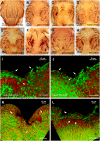Identification and functional analysis of healing regulators in Drosophila
- PMID: 25647511
- PMCID: PMC4315591
- DOI: 10.1371/journal.pgen.1004965
Identification and functional analysis of healing regulators in Drosophila
Abstract
Wound healing is an essential homeostatic mechanism that maintains the epithelial barrier integrity after tissue damage. Although we know the overall steps in wound healing, many of the underlying molecular mechanisms remain unclear. Genetically amenable systems, such as wound healing in Drosophila imaginal discs, do not model all aspects of the repair process. However, they do allow the less understood aspects of the healing response to be explored, e.g., which signal(s) are responsible for initiating tissue remodeling? How is sealing of the epithelia achieved? Or, what inhibitory cues cancel the healing machinery upon completion? Answering these and other questions first requires the identification and functional analysis of wound specific genes. A variety of different microarray analyses of murine and humans have identified characteristic profiles of gene expression at the wound site, however, very few functional studies in healing regulation have been carried out. We developed an experimentally controlled method that is healing-permissive and that allows live imaging and biochemical analysis of cultured imaginal discs. We performed comparative genome-wide profiling between Drosophila imaginal cells actively involved in healing versus their non-engaged siblings. Sets of potential wound-specific genes were subsequently identified. Importantly, besides identifying and categorizing new genes, we functionally tested many of their gene products by genetic interference and overexpression in healing assays. This non-saturated analysis defines a relevant set of genes whose changes in expression level are functionally significant for proper tissue repair. Amongst these we identified the TCP1 chaperonin complex as a key regulator of the actin cytoskeleton essential for the wound healing response. There is promise that our newly identified wound-healing genes will guide future work in the more complex mammalian wound healing response.
Conflict of interest statement
The authors have declared that no competing interests exist.
Figures








Similar articles
-
Role of Jun N-terminal Kinase (JNK) signaling in the wound healing and regeneration of a Drosophila melanogaster wing imaginal disc.Int J Dev Biol. 2005;49(4):391-9. doi: 10.1387/ijdb.052006jm. Int J Dev Biol. 2005. PMID: 15968584
-
A targeted UAS-RNAi screen in Drosophila larvae identifies wound closure genes regulating distinct cellular processes.Genetics. 2010 Nov;186(3):943-57. doi: 10.1534/genetics.110.121822. Epub 2010 Sep 2. Genetics. 2010. PMID: 20813879 Free PMC article.
-
Twinstar/cofilin is required for regulation of epithelial integrity and tissue growth in Drosophila.Oncogene. 2016 Sep 29;35(39):5144-54. doi: 10.1038/onc.2016.46. Epub 2016 Apr 4. Oncogene. 2016. PMID: 27041568
-
Crawling wounded: molecular genetic insights into wound healing from Drosophila larvae.Int J Dev Biol. 2018;62(6-7-8):479-489. doi: 10.1387/ijdb.180085mg. Int J Dev Biol. 2018. PMID: 29938760 Free PMC article. Review.
-
Drosophila Imaginal Discs as a Model of Epithelial Wound Repair and Regeneration.Adv Wound Care (New Rochelle). 2016 Jun 1;5(6):251-261. doi: 10.1089/wound.2014.0547. Adv Wound Care (New Rochelle). 2016. PMID: 27274435 Free PMC article. Review.
Cited by
-
Imaginal Disc Regeneration: Something Old, Something New.Cold Spring Harb Perspect Biol. 2022 Nov 1;14(11):a040733. doi: 10.1101/cshperspect.a040733. Cold Spring Harb Perspect Biol. 2022. PMID: 34872971 Free PMC article. Review.
-
Requirement for and polarized localization of integrin proteins during Drosophila wound closure.Mol Biol Cell. 2018 Sep 1;29(18):2137-2147. doi: 10.1091/mbc.E17-11-0635. Epub 2018 Jul 11. Mol Biol Cell. 2018. PMID: 29995573 Free PMC article.
-
ROS-Induced JNK and p38 Signaling Is Required for Unpaired Cytokine Activation during Drosophila Regeneration.PLoS Genet. 2015 Oct 23;11(10):e1005595. doi: 10.1371/journal.pgen.1005595. eCollection 2015 Oct. PLoS Genet. 2015. PMID: 26496642 Free PMC article.
-
Regulation of Epithelial and Endothelial Barriers by Molecular Chaperones.Cells. 2024 Feb 21;13(5):370. doi: 10.3390/cells13050370. Cells. 2024. PMID: 38474334 Free PMC article. Review.
-
Shared enhancer gene regulatory networks between wound and oncogenic programs.Elife. 2023 May 3;12:e81173. doi: 10.7554/eLife.81173. Elife. 2023. PMID: 37133250 Free PMC article.
References
Publication types
MeSH terms
Substances
LinkOut - more resources
Full Text Sources
Other Literature Sources
Molecular Biology Databases
Research Materials

